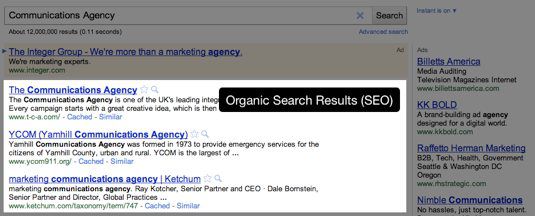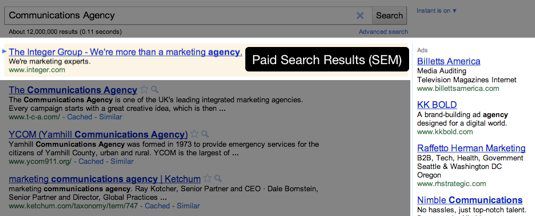Either if you're starting a new business or just looking to grow your existing one — strong and consistent marketing should be a major part of your business plan. Great opportunities abound online, but where to start?
In this post we'll go over your main options, their benefits and the respective costs. Trying out these methods will help you reach new customers, promote your brand and expand your business.
Search Engine Optimization (SEO)

Search Engine Optimization (SEO) refers to tweaking your website's contents, organization & inbound links in order to better place for strategically chosen keywords in a Search Engine's index. Specifically, you're looking for keywords that support your business goals, have a low amount of search competition and have a high number of monthly searches. Search Engines seek to provide relevant results to searchers, so it's important that you match your site to relevant keywords to drive good traffic to your site. Each SEO campaign has three essential steps:
Keyword Research & Competitor Analysis Onsite Optimization Offsite Optimization (Link Building)
In terms of audience reach, if you pick your keywords carefully, you can reach a fairly targeted group of potential customers. Google Search accounts for about 80% of USA search trafficso you'll want to target your efforts with them, Bing & others watch Google search results so you'll also experience some trickle down to other sites.
SEO is a large, long-term investment, both in time and money. When you start your SEO campaign, it can take a month or two to start seeing results. However, unlike performance-based marketing (ads) it's mostly a one-time cost. SEO represents the best long-term investment of your money and we deem it essential for every business website.
Search Engine Marketing (SEM/PPC) & Paid Text Ads

If you're looking to drive traffic to your site immediately there is no better way that Paid Text Ads — plus you can do it in very targeted way, bringing in well qualified customers.
You have two major options, Google Adwords and Facebook Advertising. Both systems use similar auction-based methods of purchase. Essentially there is a limited number of advertising slots, each company picks a advertisement criteria and an amount your are willing to pay to have your ad display. The top amounts paid (10 for Google, 5 for Facebook) show for a given page view. The ads shown & amounts paid shift dynamically through the day as links are clicked & daily payment maximums are reached.
In Adwords you bid for specific keywords while on Facebook you bid on user profiles & criteria such as geographic location, education level, career, age, etc. You get much more targeted impressions with Facebook over Google, but you'll reach more new customers & conversion centric buyers on Google.
The key to a successful SEM campaign is constant monitoring of your performance & tweaking to get a better return on your investment.
Display Ads

Display ads are fairly simple — they're a great way to drive traffic as well as increase your brand recognition — the only trouble is their expense. You pay on an Impression Basis (CPM), you pax XX amount per thousand times the ad is loaded (in contrast to PPC). It's not much per thousand, but it quickly adds up on high-traffic sites.
You typically buy ads through Display Ad Networks, the king of which is DoubleClick (recently bought by Google). Their are also many smaller display networks, or in some cases you can buy them individually from the website publisher.
Display Networks match your business to sites that represent your industry, hoping that the audience will be interested in your product — creating a very broad audience match.
Some networks also act as brokers, allowing you to pick sites you'd like your ad to be seen on. One of note is BuySellAds.com, we suggest you use them if you're just trying our display ads for the first time.
Social Media
Facebook & Twitter are the two dominant social media platforms in the United States, yet to a business they serve two very different functions. The only cost is time, to be effective we recommend posting multiple times a day on each service. Be personable, share your knowledge and make some friends.
Facebook is centered around friendships & relationships with people and with businesses. Facebook users skew more female, younger and less educated than Twitter users. They tend to follow brands with more loyalty, but are less commerce centric in their actions. Your posts and updates will largely build up your audience & customer loyalty, not necessarily reach new customers.
Twitter is a better way to reach new customers than Facebook as it's more search-centric than Facebook. Users are more exploratory and tend to follow people along their interests. It's a great place to expand your market, speak to your niche and prove your expertise in your industry.
[Shameless plug, follow @GRAYBOXComm on Twitter]
E-Mail Marketing
E-mail marketing is a great way to retain your existing customers and keep them engaged in your brand — the trouble is building and maintaining your customer file in compliance with the CAN-SPAM Act. Don't purchase a list (they typically perform very badly), but slowly gather names from customers and collect them on your site.
There are a lot of great tools out there, MailChimp or Campaign Monitor for small-businesses; iContact for medium-sized businesses, and Bronto or ExactTarget for Enterprise Solutions level needs.
You'll typically pay a cent or two for each e-mail sent. This doesn't sound like much, but can really add up when you have a large customer list & send often.
Affiliate Marketing
Affiliate Marketing is essentially paying a small commission on your sales to get others to link to products on your site. It works best for ecommerce companies that offer a variety of products.
It's hard to get affiliates on your own, so we highly recommend using an Affiliate Network — the king of the hill is Commission Junction, but there are plenty of industry specific options as well.
Conclusion
As you can see, there are plenty of options to promote your business online — our best advice is to experiment with multiple options, consistently review your ROI, and tweak your campaigns and trying new marketing ideas. If you need help, GrayBox has multiple marketing, ecommerce and internet business consultants to help you develop your online marketing strategy. Get in touch.
